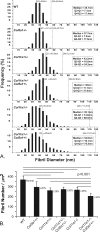Regulation of collagen fibril nucleation and initial fibril assembly involves coordinate interactions with collagens V and XI in developing tendon
- PMID: 21467034
- PMCID: PMC3121453
- DOI: 10.1074/jbc.M111.223693
Regulation of collagen fibril nucleation and initial fibril assembly involves coordinate interactions with collagens V and XI in developing tendon
Abstract
Collagens V and XI comprise a single regulatory type of fibril-forming collagen with multiple isoforms. Both co-assemble with collagen I or II to form heterotypic fibrils and have been implicated in regulation of fibril assembly. The objective of this study was to determine the roles of collagens V and XI in the regulation of tendon fibrillogenesis. Flexor digitorum longus tendons from a haplo-insufficient collagen V mouse model of classic Ehlers Danlos syndrome (EDS) had decreased biomechanical stiffness compared with controls consistent with joint laxity in EDS patients. However, fibril structure was relatively normal, an unexpected finding given the altered fibrils observed in dermis and cornea from this model. This suggested roles for other related molecules, i.e. collagen XI, and compound Col5a1(+/-),Col11a1(+/-) tendons had altered fibril structures, supporting a role for collagen XI. To further evaluate this, transcript expression was analyzed in wild type tendons. During development (E18-P10) both collagen V and XI were comparably expressed; however, collagen V predominated in mature (P30) tendons. The collagens had a similar expression pattern. Tendons with altered collagen V and/or XI expression (Col5a1(+/-); Col11a1(+/-); Col5a1(+/-),Col11a1(+/-); Col11a1(-/-); Col5a1(+/-),Col11a1(-/-)) were analyzed at E18. All genotypes demonstrated a reduced fibril number and altered structure. This phenotype was more severe with a reduction in collagen XI. However, the absence of collagen XI with a reduction in collagen V was associated with the most severe fibril phenotype. The data demonstrate coordinate roles for collagens V and XI in the regulation of fibril nucleation and assembly during tendon development.
Figures






Similar articles
-
Collagen XI regulates the acquisition of collagen fibril structure, organization and functional properties in tendon.Matrix Biol. 2020 Dec;94:77-94. doi: 10.1016/j.matbio.2020.09.001. Epub 2020 Sep 17. Matrix Biol. 2020. PMID: 32950601 Free PMC article.
-
Targeted deletion of collagen V in tendons and ligaments results in a classic Ehlers-Danlos syndrome joint phenotype.Am J Pathol. 2015 May;185(5):1436-47. doi: 10.1016/j.ajpath.2015.01.031. Epub 2015 Mar 20. Am J Pathol. 2015. PMID: 25797646 Free PMC article.
-
Murine model of the Ehlers-Danlos syndrome. col5a1 haploinsufficiency disrupts collagen fibril assembly at multiple stages.J Biol Chem. 2006 May 5;281(18):12888-95. doi: 10.1074/jbc.M511528200. Epub 2006 Feb 20. J Biol Chem. 2006. PMID: 16492673
-
Development of tendon structure and function: regulation of collagen fibrillogenesis.J Musculoskelet Neuronal Interact. 2005 Mar;5(1):5-21. J Musculoskelet Neuronal Interact. 2005. PMID: 15788867 Review.
-
Molecular genetics in classic Ehlers-Danlos syndrome.Am J Med Genet C Semin Med Genet. 2005 Nov 15;139C(1):17-23. doi: 10.1002/ajmg.c.30070. Am J Med Genet C Semin Med Genet. 2005. PMID: 16278879 Review.
Cited by
-
Collagen XI regulates the acquisition of collagen fibril structure, organization and functional properties in tendon.Matrix Biol. 2020 Dec;94:77-94. doi: 10.1016/j.matbio.2020.09.001. Epub 2020 Sep 17. Matrix Biol. 2020. PMID: 32950601 Free PMC article.
-
Upregulation of distinct collagen transcripts in post-surgery scar tissue: a study of conjunctival fibrosis.Dis Model Mech. 2017 Jun 1;10(6):751-760. doi: 10.1242/dmm.028555. Epub 2017 Mar 22. Dis Model Mech. 2017. PMID: 28331057 Free PMC article.
-
Type I collagen D-spacing in fibril bundles of dermis, tendon, and bone: bridging between nano- and micro-level tissue hierarchy.ACS Nano. 2012 Nov 27;6(11):9503-14. doi: 10.1021/nn302483x. Epub 2012 Oct 22. ACS Nano. 2012. PMID: 23083115 Free PMC article.
-
Mineralocorticoid Receptor Signaling Contributes to Normal Muscle Repair After Acute Injury.Front Physiol. 2019 Oct 25;10:1324. doi: 10.3389/fphys.2019.01324. eCollection 2019. Front Physiol. 2019. PMID: 31736768 Free PMC article.
-
Collagen V localizes to pericellular sites during tendon collagen fibrillogenesis.Matrix Biol. 2014 Jan;33:47-53. doi: 10.1016/j.matbio.2013.08.003. Epub 2013 Aug 15. Matrix Biol. 2014. PMID: 23954412 Free PMC article.
References
-
- Beighton P. (1992) in McKusick's Heritable Disorders of Connective Tissue (Beighton P. ed) pp. 189–251, Mosby, St. Louis, MO
-
- Steinmann B. (2002) in Connective Tissue and Its Heritable Disorders (Royce P. ed) pp. 431–523, Wiley-Liss, Inc., New York, NY
-
- Sokolov B. P., Prytkov A. N., Tromp G., Knowlton R. G., Prockop D. J. (1991) Hum. Genet. 88, 125–129 - PubMed
-
- Wordsworth B. P., Ogilvie D. J., Sykes B. C. (1991) Br. J. Rheumatol. 30, 173–177 - PubMed
-
- Burrows N. P., Nicholls A. C., Yates J. R., Gatward G., Sarathachandra P., Richards A., Pope F. M. (1996) J. Invest. Dermatol. 106, 1273–1276 - PubMed
Publication types
MeSH terms
Substances
Grants and funding
LinkOut - more resources
Full Text Sources
Other Literature Sources
Medical
Molecular Biology Databases
Miscellaneous

